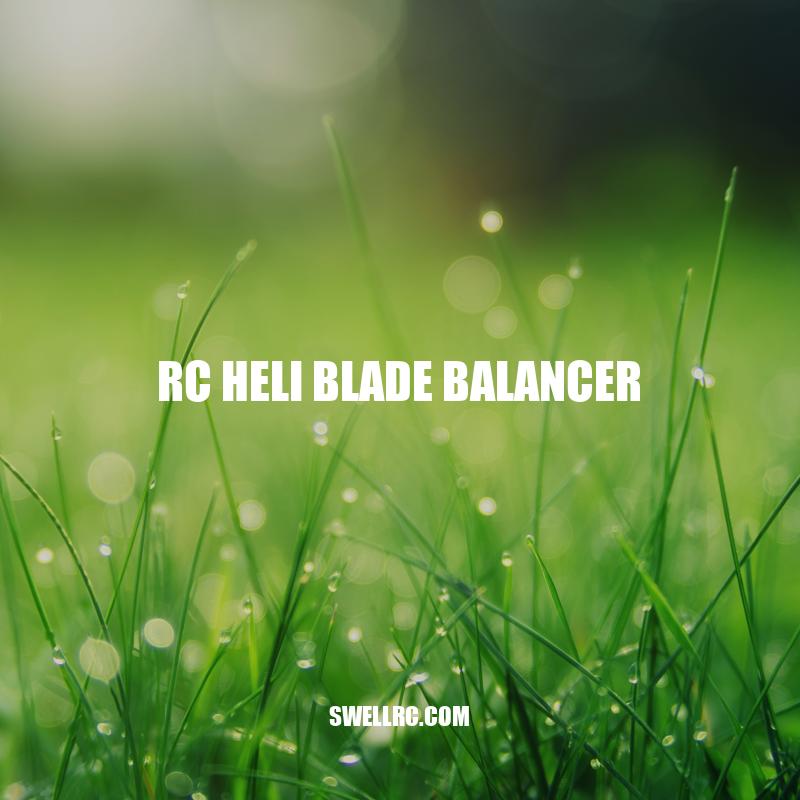Master the Skies with an RC Heli Blade Balancer
RC helicopters are fascinating flying machines that require precision and balance. One of the most important aspects of owning and operating an RC helicopter is ensuring that the rotors (blades) are correctly balanced. Unbalanced blades can lead to a host of problems, including diminished flight performance, excessive wear on parts over time, and, in some cases, even dangerous accidents. That’s where the RC heli blade balancer comes in. The blade balancer helps determine if your blades are evened out, ensuring that your helicopter operates at its highest level. In this article, we’ll offer an overview of what an RC heli blade balancer is, how it works, and why proper blade balancing is so important. If you’re an RC helicopter enthusiast and want to maintain your helicopter’s performance, read on to learn about the blade balancer and how to use it effectively.
What is an RC heli blade balancer?
An RC heli blade balancer is a device that helps determine if the rotor blades on an RC helicopter are balanced correctly. The blade balancer typically consists of a base and a rod with an adjustable cone on one end to accommodate the various blade sizes. When placed vertically, the balancer allows you to determine the evenness of each blade by measuring its weight distribution.
Some additional information about the blade balancer includes:
- There are manual and digital blade balancers available in the market.
- Manual blade balancers use gravity to detect weight distribution, while digital balancers use sensors.
- Digital blade balancers can display real-time data on the adjustment of blade balance.
- Various blade balancers are available online, including on Amazon, Hobbyking, and Tower Hobbies.
Using an RC heli blade balancer is essential if you want to maintain your helicopter’s performance and ensure safety while flying it. Balancing your rotor blades can seem complicated, but with a little practice, you can learn how to do it quickly and accurately. In the following section, we’ll discuss why proper blade balancing is so important for your RC helicopter.
Why is it important to balance RC heli blades?
Properly balanced rotor blades are essential for the safe and effective operation of RC helicopters. Here are a few reasons why:
- Unbalanced blades can lead to excessive vibration and wear on the helicopter’s components, including its motor, bearings, and grips.
- Unbalanced blades can cause the helicopter to fly in an unstable manner, making it difficult to control and posing a safety risk.
- In some cases, unbalanced blades can cause the helicopter to crash, resulting in significant damage to the helicopter and any nearby property or people.
To better understand the effects of unbalanced blades, take a look at the table below, which shows some of the common symptoms of blade imbalance and their potential causes:
| Symptom | Potential Causes |
|---|---|
| Excessive vibration | One or both blades are too heavy or too light |
| Poor tracking | Blades are not of the same length, weight, or shape |
| Difficulty controlling the helicopter | One or both blades are considerably out of balance, causing the helicopter to yaw or drift in flight |
As you can see, blade imbalance can lead to a range of problems that can significantly affect the performance and safety of your RC helicopter. In the next section, we’ll take a look at how to use an RC heli blade balancer to ensure that your rotor blades are in balance.
RC heli blade balancers are tools that allow you to measure the weight and balance of the rotor blades on your RC helicopter. Most balancers consist of a base, a pivot, and a set of leveling bubbles or electronic sensors that help you determine whether the blades are properly balanced.
To use an RC heli blade balancer, you first need to remove the blades from your helicopter. Then, you’ll mount each blade on the balancer’s pivot and use the leveling bubbles or sensors to ensure that the blade is at a perfect 90-degree angle to the balancer’s base. Next, you’ll record the weight of each blade and compare them. If there’s a significant difference in weight, you can add small weights to the lighter blade until they both weigh the same.
Once both blades are of equal weight, you can use the balancer’s leveling system to check for any minor differences in balance. You’ll need to adjust the position or weight of each blade until they are both perfectly balanced and the bubble is centered.
Keep in mind that balancing your rotor blades may take some trial and error, and it’s important to be patient and meticulous to ensure that your helicopter runs smoothly and safely. By using an RC heli blade balancer and taking the time to balance your blades properly, you’ll enjoy a more enjoyable, safer flying experience.
Is a helicopter balanced or unbalanced?
A helicopter is unbalanced, as its center of mass is located above the rotor system. To remain stable, it requires a tail rotor or anti-torque system to counterbalance the torque produced by the rotor blades. Additional information about helicopters and their features can be found on websites such as helicopterhistory.org and helicoptersonly.com, or in products such as the book “Understanding Helicopter Aerodynamics” by R. W. Prouty.
| Pros | Cons |
|---|---|
| Vertical take-off and landing capabilities | High maintenance costs |
| Maneuverability in tight spaces | Expensive to purchase |
| Ability to hover in the air | Noisy |
- Helicopter pilots require extensive training and hours of experience to operate safely
- Helicopters are commonly used for medical emergencies, military operations, and aerial photography or surveying
- Helicopters come in various sizes and designs, including single-rotor and multi-rotor configurations
How to use an RC heli blade balancer
Using an RC heli blade balancer is a straightforward process that can be completed in a few simple steps. Here’s what you need to do:
- Set up the blade balancer on a flat and stable surface. It’s important to ensure that the balancer is level and that there are no vibrations that could interfere with the reading.
- Attach one blade to the balancer and allow it to settle. The blade should be fully assembled, including any weights or other accessories that will be used during flight.
- Check the balance of the blade. This can be done by observing the position of the blade on the balancer and adjusting any weights as necessary until the blade is perfectly balanced.
- Repeat the process with the second blade until both blades are perfectly balanced.
- Once the blades are balanced, reattach them to the helicopter and perform a test flight to ensure that the helicopter flies smoothly and without vibration.
It’s worth noting that different blade balancers may have slightly different instructions or requirements, so be sure to consult the user manual for the specific brand and model that you’re using.
If you’re in the market for an RC heli blade balancer, there are a variety of options to choose from online. Some popular brands include:
Before making a purchase, be sure to read reviews and compare features to determine which blade balancer is the best fit for your needs and budget.
Common mistakes to avoid while using an RC heli blade balancer
While using an RC heli blade balancer may seem straightforward, there are certain mistakes that beginners may make that can result in unbalanced blades and potential damage to the helicopter. Here are some common mistakes to avoid:
- Not setting up the blade balancer on a flat and stable surface
- Using a wobbly or unlevel surface, which can affect the accuracy of the reading
- Not assembling the blades fully and inserting any weights or other accessories that will be used during flight
- Not taking enough time to adjust the weights until the blade is properly balanced
- Using the blade balancer in a location where there are strong winds or vibrations
- Trying to balance the blades by eye or touch rather than using a blade balancer
- Using a blade balancer that is not compatible with the type of blades or helicopter that you’re using
Avoiding these mistakes can help ensure that your helicopter’s blades are properly balanced and that you can enjoy smooth and safe flights.
If you’re unsure about how to use a blade balancer or you want to learn more about the process of balancing helicopter blades, there are a variety of resources available online. Some websites to check out include:
- RCGroups.com – an online forum for RC enthusiasts with a dedicated section for helicopters and balancing blades
- Heliguy.com – a website that offers tutorials and tips for beginners learning to fly helicopters
- Helifreak.com – an online forum for helicopter enthusiasts with discussions on blade balancing and other topics
By taking the time to educate yourself and avoid common mistakes, you can increase your proficiency and enjoyment of flying RC helicopters.
What is balancing the main rotor for a helicopter?
Balancing the main rotor for a helicopter is a process that ensures the rotor blades are evenly weighted and distributed around the rotor hub. To achieve this, each blade is adjusted by adding or removing small weights until they are all balanced.
Balancing the main rotor is crucial for safe and efficient flight as unbalanced blades can cause excessive vibrations, leading to mechanical failure and loss of control.
Several tools and techniques are used to balance the main rotor, including:
- Static balancing: Ensures that the blades are balanced at rest and involves placing the blades on a balancing stand and adjusting weights accordingly.
- Dynamic balancing: Involves balancing the blades while they are in motion and measures vibrations using special sensors.
- Laser tracking: A high-tech method that uses laser sensors to measure the position and movement of the blades and adjust weight accordingly.
Properly balanced rotor blades are essential for safe and efficient helicopter flight. For more information on helicopter maintenance and safety, visit websites such as FAA.gov or rotor.org. There are also several products available, such as helicopter balance kits and balancing stands, to assist with the rotor balancing process.
Tips for maintaining balanced RC heli blades
Properly balancing RC heli blades is not a one-time task – it requires ongoing maintenance to ensure that the helicopter is performing optimally. Here are some tips for maintaining balanced blades:
- Regularly check the balance of the blades, especially after any crashes or rough landings
- Inspect the blades for damage or wear and replace them if necessary
- Keep the blades clean and free of debris, which can throw off the balance
- Store the blades in a secure location, protected from impacts or vibrations
- Use a blade holder or storage tray to keep the blades organized and protected
- Follow the manufacturer’s instructions for any accessories or weights to use on the blades
- If you’re unsure about how to maintain the balance of your blades, consult with an RC helicopter expert or community
By following these tips, you can help ensure that your RC heli blades remain balanced and perform optimally during flights.
There are also a variety of products available on the market to help with blade balancing and maintenance. Some popular products include:
| Product | Description | Website |
|---|---|---|
| SkyRC Blade Balancer | A portable and easy-to-use blade balancer that supports a variety of blade sizes | skychina.com |
| Blade Tracking Tape | A specialized tape that helps to visualize and adjust blade tracking | horizonhobby.com |
| Blade Holder Tray | A tool for securely storing and transporting blades | rotorron.com |
These products can help make the task of balancing and maintaining blades easier and more efficient.
How do you balance RC helicopter blades?
Balancing RC helicopter blades is crucial to ensure smooth flights and avoiding damage to the helicopter. Here are the steps you need to follow to balance the blades:
- Remove the blades from the helicopter and clean them.
- Put the blades on a blade balancer, which you can purchase online or at a hobby store.
- Check if the blades are balanced by seeing if they sit level with the balancer.
- If the blade is not balanced, add a small amount of tape or weight to the lighter blade until they both sit level.
- Repeat the process for the other blade.
- Once both blades are balanced, install them back onto the helicopter and double-check balance using the blade-balancing tool on the helicopter itself.
If you need more information or want to watch a tutorial, check out online forums and websites like RCGroups.com or Heliguy.com. Additionally, you can purchase balancing kits and tools from Amazon or a hobby store.
Conclusion
In conclusion, balancing the blades of an RC heli is an essential task that every pilot should take seriously. Unbalanced blades can decrease the performance of the helicopter and even lead to accidents. By using an RC heli blade balancer and following the tips for maintaining balanced blades, you can ensure that your helicopter is performing at its best.
Additionally, investing in quality products like blade holders, tracking tape, and balancers can help make this task easier and more efficient. Doing so not only saves you time and effort but also helps ensure the safety and longevity of your helicopter.
Remember, when it comes to RC helis, balance is key. Take the time to check and maintain your blade balance regularly, and you’ll be rewarded with a more enjoyable flying experience.



